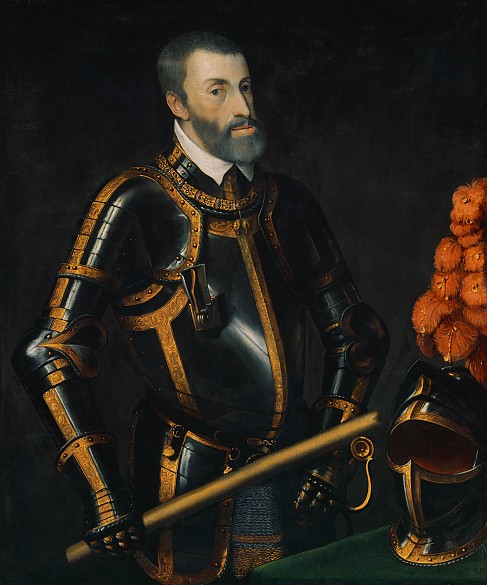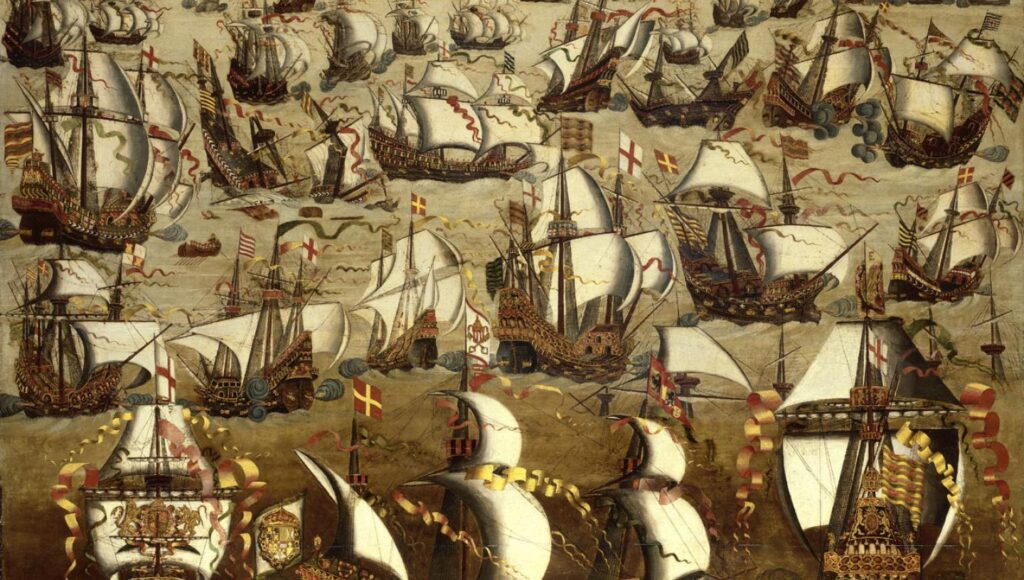In the 16th century, Emperor Charles V of the Austrian von Habsburg family sat at the helm of much of Europe.
He sat on the thrones of Spain, several central European kingdoms, several Italian states, and many principalities in the Holy Roman Empire.
Yet, by the mid-1500s, this massive pan-European empire had split, with two branches of the Habsburg line consolidating their rule over two different parts of Charles’s inheritance.
One would rule from Madrid, and the other from Vienna – never reuniting again under one ruler.
In this piece, we will explain how Charles inherited his enormous empire and the events that led to the creation of separate Austrian and Spanish Habsburg dynasties.
But more importantly, we shall discuss the rise and fall of the Habsburgs and their failure to gain mastery over Europe during the war-filled period stretching from the 1520s until the 1640s.
Charles’ Inheritance
Although there were specific reasons as to why each state joined these series of conflicts, they can broadly be split into two.
These two factors were the catalysts that meant 16th-century Europe was about to undergo a change that would change it forever.
The first was religious, and it was the Reformation.
In case you were not aware, in the early 1500s, there was a religious movement in Europe led by a man named Martin Luther to reform the Catholic Church.
This ended up splitting Europe between the Catholics (mostly Southern Europe), and the Protestants (comprising mostly Northern Europe).
This would add a religious element to warfare during this period, leading to a transnational struggle that was more brutal and less open to compromise than ever before.
The war over religion would carry on until the mid-17th century after over 100 years of war when an exhausted Europe finally accepted the continent’s confessional divide.
The second crucial element to this change in Europe was the rise of the Habsburgs dynasty who had managed to amass lands stretching from Gibraltar to Hungary, Sicily to Amsterdam.
This was important as this sort of concentration of power in Europe, a continent that has always tended towards political plurality, had not been seen for 700 years since the reign of Charlemagne.
The Habsburgs had by the 16th century managed to regularly get themselves elected to the position of Holy Roman Emperor.
The Holy Roman Empire was a conglomeration of mostly Germanic states which the Habsburgs wished to dominate.

However, the position of the emperor had lost a lot of power over the years as many German princes sought to minimize the influence of the emperor.
Nevertheless, the title still carried much prestige which the Habsburgs welcomed.
In addition, the Habsburgs were second to none when it came to augmenting their holdings through marriages and inheritance.
As early as 1477, Emperor Maximillian I had managed to acquire the rich lands of Burgundy along with the Netherlands through his marriage to Mary of Burgandy.
The lands of Hungary and Bohemia which gave the Habsburgs power in central Europe were also added in 1515 through marriage.
But by far the most important move Maximillian made was getting his son married to the daughter of Isabella and Ferdinand of Spain.
And the ‘residuary heir’ to all these marriage deals was their son, Charles V.
Yet, the sheer diffusion of these lands and lack of homogeneity meant they could not realistically be ruled in the same manner as Oriental empires such as the Ottomans or Ming China.
In fact, early on this was made clear. In the 1520s, Charles gave most of the control over the administration of Austria, along with Hungary and Bohemia to his younger brother Ferdinand.
And it showed that both Austria and Spain could not be ruled by the same person.
Yet, their European rivals did not see it that way.
This was especially in the case of the French who feared the increasing Habsburg encirclement of their lands, but it also alarmed the Protestant princes of Germany and even the Pope, despite sharing the same Catholic religion as the Habsburgs
So, this meant that the Habsburgs would not go unchallenged and that they would soon embark on a long period of warfare.
But what made the warfare worse during this period was that Charles V and his successors, Ferdinand II, Philip II, and Philip IV were some of the most militant in their Catholicism.
Hence, it was now impossible to separate politics and power from religion.
This also meant that if Charles V had managed to crush the Protestant princes of Germany in the 1540s, this not only would have been a win for the Habsburgs but also for Catholicism.
The same was true when the Spanish tried to suppress the Dutch Revolt in 1566 and the sending of the Spanish Armada to England in 1588.
Yet, despite their neighbors’ worries, dominating Europe was actually not an explicit aim of the Habsburgs.
In fact, these inheritances of land had very much to do with luck rather than through conscious planning to dominate Europe like Napoleon or Hitler.
And often, it was they who were provoked rather than provoking.
Yet, even if they had secured their defensive aims, they still would have been masters of Europe.
This would have meant that their greatest threat, the Ottomans, would have been driven back out of the Mediterranean and into North Africa
Heresy would have been suppressed in Germany and revolt in the Netherlands crushed.
Friendly regimes would be maintained in France and England
Only Eastern Europe, Muscovy, Scandinavia, and Ottoman lands would not feel Habsburg power.
And although their authority would not be like that of the Ottoman or Chinese Empires, pluralism would still have been greatly diminished in Europe.
Italian Wars against France
What is interesting about warfare after the year 1500 is the sheer length of these struggles.
Gone were the days of war being conducted within a short couple of years.
For example, the conflict between the Austrians and the Ottomans went on decade after decade.
The attempt by Spain to put down the Dutch Revolt went on from 1560 to 1648 and is known as the Eighty Years’ War.
The final spasm of warfare between the coalition powers and the Habsburgs went from 1618 to 1648 and is now called the Thirty Years’ War.
In a manner unlike before, the capacity of each state to wage a war for this long was put on show. The military encounters of the 1520s would seem very small-scale compared to the 1630s in terms of both men and the finances war demanded.
The first series of wars with the Habsburgs were focused on Italy. Its rich, vulnerable city-states had tempted the French as early as 1494 and would often force many states such as Spain, Austria, and even the English to enter and check their ambitions.
Spain and France were still arguing in 1519 over claim to the latter’s claim to Milan when news arrived about Charles V’s vast inheritance.
So, sensing the hour was ripe, the ambitious Francis I of France instigated a series of countermoves not just in Italy, but also along the borders of Burgundy, the Netherlands, and Spain against his new archrival.
But he wasn’t very successful.

Given the imbalance in their respective forces, it was not too hard for Charles to keep blocking French interest in Italy, but that didn’t stop Francis from constantly fighting for these Italian possessions well into the 1540s.
And that was not his only problem, as Charles had also inherited many new enemies along with his territorial inheritance.
Most formidable amongst them at the time were the Ottomans who were even at one point besieging Vienna in 1529 and provided a near-constant naval threat to his Spanish and Italian holdings.
Additionally, the Protestant princes of Germany provided many headaches for the emperor, but because of France, he could not focus on the region until after the 1540s.
Division of the Empire
When he did finally focus, he was at first quite successful, even famously beating in 1547 a coalition of German princes at Mühlberg.
Yet, as will be a recurring pattern, this Habsburg victory frightened its rivals such as the North German princes, the Ottomans, and Henry II of France who then all strove to weaken him.
And that is exactly what happened.
After France entered on the side of protestant Germans (despite France being Catholic), they were soon able to resist Austria.
It was at this point, after suffering from much weariness during a reign filled with war, that Charles V chose to abdicate from the throne in 1556. He would be the last monarch to hold such a large array of lands and titles in Europe.
This was because he chose to split the empire into a western branch centered on Spain, ruled by his son, Philip II, and an eastern branch centered on Austria, ruled by his brother and new Holy Roman Emperor, Ferdinand I.
Yet, even after its dynastic split, the conflict with the Habsburgs in Europe would carry on. But for now, the Austrian side, headed by Ferdinand I and then his successor Maximilian II, would see relative peace.
But the Spanish side was not so lucky.
Eighty Years’ War
The Spanish would carry on constantly warring with Ottomans, who wanted dominance in the Mediterranean, until a truce in 1581.
And the same time Philip II’s religious intolerance and imposition of high taxes had rekindled discontent in the Netherlands. And when authority broke down in the 1560’s, he made things worse by responding with full military despotism which only alarmed the English, French, the Germans.
The English especially were more perturbed when in 1580 Spain annexed Portugal.
And so, yet again, Spain’s rivals would come in to keep the balance of power in Europe.
So, by the 1580s the Dutch struggle had become an international struggle and the second of the three main Habsburg wars against its European rivals.
While at the beginning of this war, the French would play a lesser role due to their own bitter religious civil war, the English played a much larger role this time. By then Elizabeth I had checked threats to her authority and started decidedly backing the Dutch rebels with military support.
At sea, Dutch and English privateers would work together to disrupt Spanish supplies which aimed to aid their war in the Netherlands.
However, at times, especially between the 1580s and 90s, it seemed as though the Spanish might actually succeed against the coalition, especially in 1588 when they sent the Spanish Armada to conquer England, and in 1590 when they were at one point advancing on Paris.
Yet the coalition lines would hold.

And when a reinvigorated French fully rejoined the war, the tables would turn against Spain.
After this, Spain soon sued for peace with England in 1604, and then 5 years later, negotiated peace with the Dutch rebels.
This made it very clear that Spanish power was not enough to crush its European rivals, and that the Europe of 1600 was still plural and of many, independent nations.
Yet that was not the last of Habsburg’s wars, as there was to be a third, conclusive war that would finally check Habsburg ambitions.
And this last spasm of warfare would fall heavily upon Germany.
Thirty Years’ War
This conflict started when the confessional struggle between the Protestants and Catholics in Germany once again flared up.
Both sides had started drawing up alliances: on one side the Protestant League, which had ties to both the Dutch and the English, had been formed in 1608 by a few protestant princes.
The Catholic League was soon formed in response and was backed by the Austrians, along with their Spanish cousins.
Yet again, a war on an international scale was brewing.
The trigger came when a revolt in Protestant Bohemia against its new catholic ruler provided the spark in 1618. First, the Spanish would enter, and then the Dutch, and in 1626, even the Danish would join.
And just like the previous Eighty Years’ War, the Habsburgs were off to a winning start.
In fact, by the late 1620s, it seemed the Habsburgs were going to establish centralized control over Germany and were even going to reach the Baltic shores.
But as often happens in Europe, this alarming and rapid power grab coerced more enemies to act, and in the early 1630s Sweden joined, followed by France in 1635.
Consequently, the tides started turning against the Habsburgs, but not through no fault of their own.
For example, the Spanish decided on a triple invasion of France after it had joined, but they soon found themselves overstretched. This severely hampered their effectiveness as the war rumbled on.
Also, by 1640, not only were the Dutch and the French counterattacking, but Portugal had also revolted against Spanish rule, which forced the Spanish to divert valuable resources closer to home.
As the war went on, the armies became smaller, governments became more financially desperate, and the people’s patience became thinner.
Therefore, secret peace discussions were taking place at all fronts of the conflict, and as a result, the end of the Thirty Years’ War was a thoroughly untidy affair.
Peace, At Last
Spain made the move first by making peace with the Dutch Republic early in 1648 and gave them full independence, simply to deprive France of an ally.
It became purely a French-Spanish struggle when the Treaty of Westphalia brought peace to Germany, which allowed the Austrians to retire.
It was only after France allied with Oliver Cromwell’s England (the war had little to do with religion by then) in 1655 that the final blows forced Spain to sue for peace, culminating in the surprisingly not-so-harsh Treaty of the Pyrenees in 1659.
That finally spelled the end of the Habsburg bid for mastery over Europe, and all that was left for Spain to do was reestablish its control over Portugal, but this too ended in failure.
So, all in all, despite much war and carnage since the ascension of Charles V in 1519, Europe would stay very much politically fragmented despite the Habsburg’s best attempts to change otherwise.
Peace had, at last, finally arrived in Europe.
Footnotes & Further Reading
Kennedy, Paul M. The Rise and Fall of the Great Powers: Economic Change and Military Conflict from 1500-2000. London: William Collins, 2017.


